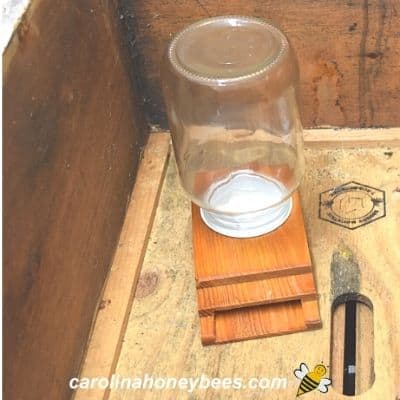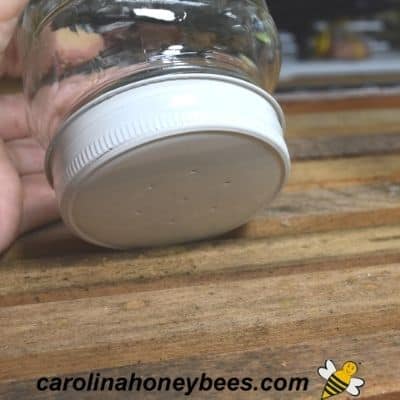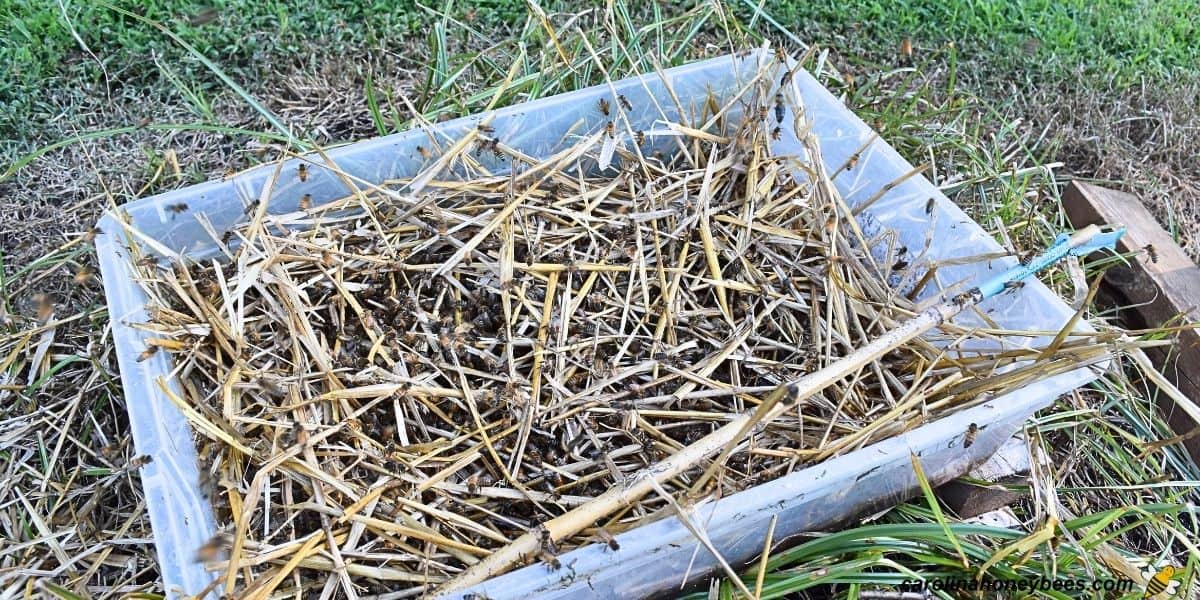Bee Feeders
Feeding bees during times of nectar shortages is an important beekeeping skill. Choosing the right bee feeder for your hives can make a big difference in the ease of managing this task. In this guide, I will share with you the most common feeders used for bees and the pros and cons of each – along with my favorite methods.

With years of beekeeping experience, I am familiar with the struggles of making sugar water for bees in a efficient manner. Getting it to the bee yard and into the hives that need it-is not always easy. Over time, you will find the best method that works for you.
Choosing the Right Honey Bee Feeder
Sometimes, we humans make things more difficult than they have to be. A bee feeder can be a simple inverted jar with a hole in the lid.
However, in order to get food to your hives in the safest most efficient manner, you will need to consider the various ways of providing nourishment to your hive. Then, choose the method that fits your needs and the needs of your hives.
Most common feeders for honey bees:
- boardman / mason jar
- hive top
- frame
- pail
- open feeding
Boardman Feeder (Entrance Feeder)
This is the most popular type of bee feeder as it is the easiest for beekeepers to use – and it is low cost. You will find it included in most beekeeping kits. A common glass or plastic jar sits in a wooden holder that is inserted into the front hive entrance.

Pros:
- easy to refill
- inexpensive
- clear container shows when its empty
Cons:
- smell will attract wasps (hornets) and other insects
- may increase chances or robbing
- does not hold much syrup
A beekeeper can easily see when to refill this type of feeder. But, a hungry colony can drain this in a couple of hours -are you available to refill it several times a day?
An even bigger issue, food hanging on the front of the hive can encourage robbing bee attacks. If you want to use a boardman feeder, it is best to place it inside the hive – with an extra box to enclose the feeder.
Mason Jar Feeder
This is basically the same as the boardman without the fancy wooden holder. It is really easy to make a mason jar bee feeder, because almost everyone has an extra glass jar around.

You can also place several jars (4) inside the hive at once – sitting on the inner cover and elevated just a bit.
Use an extra deep hive box or brood box to enclose the jars and then put the top back on the hive. This allows the bees to have access to a gallon of food inside the hive.
Rather than placing it inside the hive – some beekeepers use a temporary hive top with a 1″ – 2″ hole in the top.
The upside-down jar is placed over the hole so bees can reach the feeder holes. Weigh down the jar with a brick or strap. We do not want the wind or a raccoon to push the jar over.
Hive Top Feeders

Hive top feeders normally sit on top of the hive – just under the telescoping top. They are made of wood or plastic and are the same dimensions as a regular Langstroth hive.
They look like a short beehive box and hold around 1-2 gallons of bee syrup – feeding the colony for several days. Now, you can find variations of the large hive top feeders – I have plastic ones that I used inside the hive with a modified inner cover.
Pros:
- easy to fill without disturbing colony
- holds a lot of food
Cons:
- they have a tendency to leak over time
- they are heavy when filled
- care must be taken to avoid spilling syrup around the hive
- if the lid does not fit tight – a robbing frenzy may result
While they have their place in beehive management, my main problem with hive top feeders is that they must be removed to inspect the colony. This can be messy if you have syrup in one.
Frame Feeders

Frames feeders are often a favorite of large scale beekeepers. They have the equipment to refill them quickly. But, hobby beekeepers can use them as well.
A frame feeder sits in the hive body just like a regular frame. They have 2 solid waterproof walls with an open cavity to hold sugar water.
In fact, it takes the place of one frame in the box. If the hive normally holds 10 regular frames, you will use 9 regular frames and 1 feeder frame.
Pros:
- holds up to 1 gallon of syrup (or more)
- located inside the hive close to the clustered bees
- good option in cool weather because bees can access the food easily
Cons:
- beekeeper has to open the hive to refill
- some bees will drown in the feeders
- they may leak over time
If you choose to use frame feeders, put some type of floating material inside the compartment to reduce bee drowning. I have used small sticks or wooden Popsicle sticks.
Pail Feeders

The pail feeder or bucket feeder is also popular with beekeepers. A small plastic pail with a tight-fitting lid holds about 1 gallon of sugar syrup. Bees access the syrup through a couple of small holes or a mesh opening when the bucket is inverted.
Pros:
- lightweight and easy to handle
- holds at least 1 gallon of food
- can be inside the hive – accessible to bees in all weather
- easy to refill without disturbing colony very much
Cons:
- requires extra equipment
- mesh hole may be filled with fresh bee propolis if you let it become empty
- a small amount of liquid is wasted when first inverted
I have used pail feeders many times for my colonies. They are an excellent way to provide a lot of food to a hive in serious need.
Like the boardman feeders, pail feeders inside the hive require extra equipment. An empty hive body or deep around the pail allows the hive to be closed.
If you choose, you can use a temporary hive top with a small hole drilled in the center. Place your upturned pail over the hole. A brick or rock on top of the bucket will prevent wind damage.
Keep in mind, that when you turn the bucket upside down, to place it in the hive or over the hold in the cover – some syrup will escape until a vacuum forms. (It’s a good idea to have a bowl or something handy to catch this extra syrup).
Open Feeders
Open feeding is a method that really does not require a bee feeder at all. You simply use a container that will hold sugar water and some type of material to prevent massive bee drowning. Commercial beekeepers often use this method because is it easy to feed a lot of colonies at once.

Pros:
- easy to do – not filling individual feeders
- no feeders to clean
- no special equipment needed
- provides a lot of bee syrup
Cons:
- not an economical way to feed
- bees will drown in the container
- bees can’t access food in bad weather
- can cause robbing if used near the hives
Open feeding can be worthwhile in certain situations. I use it as an indicator of natural forage. If the bees are getting a lot of natural nectar, they will ignore the open feeder.
If they attack the feeder in mass, they are not finding a lot of food in the field. Then, I know it may be time to consider feeding internally.
This is how I use my chicken waterer bee feeder. It serves more as a guide to tell me about natural foraging conditions.
This type of bee feeder has some merits but it is also risky. It is not economical because you end up feeding every bee, wasp and yellow jacket in the area. Some bee death also results from fighting at the feeder or drowning.
If you do plan to try open feeding, ensure that the feeders are well away from your hives. A distance of at least 60-100 feet is best.
One easy method to practice open feeding is to make a bucket feeder. At least in this case, there is no drowning to worry about.
FAQs
Selecting the ideal bee feeder depends on factors such as hive size, bee behavior, and local conditions.
The frequency of refilling a bee feeder varies based on factors like bee population, nectar availability, and seasonal changes. Do not let the feeders run dry.
While most types of liquid bee food could be place in a bee feeder, it is best to only provide simple sugar water for your bees.
Bee feeders should only be used when colonies are low on stores – a new colony that needs extra food or where there is a shortage of natural food.
Finally
Beekeeper experience also plays a role in choosing the right bee feeder for your hives. Likely, you will find that you use several different types (purchased or homemade) – depending on your time and the needs of the colonies. When using them, always monitor your beehives more closely to watch for any problems.

